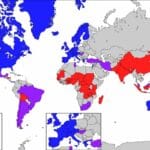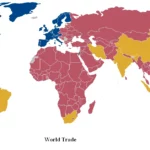Understanding acculturation is crucial for success in AP Human Geography. This article provides a comprehensive overview of acculturation, its distinctions from assimilation, the factors that influence it, real-world examples, and its significance in the context of AP Human Geography.
Understanding the Dynamics of Acculturation
Acculturation, a cornerstone concept in AP Human Geography, describes the intricate process of cultural modification resulting from sustained contact between different cultural groups. It’s a dynamic interplay where groups exchange cultural traits, influencing and reshaping each other’s customs, beliefs, and practices. This exchange, however, doesn’t necessitate the complete abandonment of one’s original culture. Instead, acculturation often involves selectively integrating new elements into an existing cultural framework. Imagine a group of immigrants learning the language of their new country while still cherishing and practicing their traditional customs and rituals. This illustrates the nuanced nature of acculturation, a process where cultural blending enriches and diversifies, rather than erases.
To draw a parallel, in the field of sociology, a process like this is called anticipatory socialisation and takes place when an individual voluntarily and intentionally conforms to the norms and values of a new culture before actually entering it.
Acculturation vs. Assimilation: A Critical Distinction
While both acculturation and assimilation involve cultural exchange, they represent distinct processes with varying outcomes. Understanding this difference is crucial for grasping the complexities of cultural interaction.
Acculturation, as previously discussed, involves incorporating elements of a new culture while retaining core aspects of one’s original cultural identity. It’s an additive process, enriching the existing cultural tapestry with new threads. Imagine adding spices to a familiar dish—the core ingredients remain, but new flavors enhance the overall experience.
Assimilation, conversely, suggests a more complete absorption into the dominant culture. This often entails abandoning original cultural traits in favor of adopting the prevailing norms and practices. Visualize a chameleon adapting to its surroundings, changing its appearance to blend seamlessly. While assimilation can facilitate integration into a new society, it may also come at the cost of diminishing one’s connection to their heritage.
The table below summarizes the key differences between acculturation and assimilation:
| Feature | Acculturation | Assimilation |
|---|---|---|
| Cultural Identity | Retained | Largely abandoned |
| Adoption of New Cultural Traits | Selective, additive | Comprehensive, often replacing existing traits |
| Pace | Gradual, evolving | Can be rapid or gradual |
| Nature | Often voluntary, can be influenced by context | Can be voluntary or involuntary, influenced by pressure |
| Outcome | Cultural blending and enrichment | Greater conformity with the dominant culture |
The Forces Shaping Acculturation
The process of acculturation is rarely uniform or predictable. It is shaped by a confluence of factors, each contributing to the unique ways cultures interact and adapt.
- Intensity of Contact: The frequency, duration, and nature of interactions between cultural groups significantly influence the rate and extent of acculturation. Frequent, prolonged contact is more likely to lead to substantial cultural exchange than sporadic, limited interactions.
- Power Dynamics: Power imbalances between groups often result in asymmetrical acculturation. The dominant culture, with its greater social, economic, and political influence, often exerts a stronger impact, potentially leading to a less balanced exchange. Historically, colonization and forced migration have resulted in the suppression of minority cultures and the imposition of dominant cultural norms.
- Voluntary vs. Forced Acculturation: Acculturation can occur voluntarily, as seen with immigrants choosing to adopt certain aspects of their new environment. However, it can also be forced upon groups through historical events, political pressures, or discriminatory practices. This distinction is critical for understanding the diverse experiences and outcomes of cultural interaction.
- Individual Agency: Individual choices and attitudes play a significant role in acculturation. Some individuals may actively embrace new cultural elements, while others may resist change and hold steadfast to their traditions. This individual variability contributes to the complex mosaic of cultural landscapes within any given society.
Acculturation in Action: Real-World Examples
Acculturation manifests in various forms across the globe, shaping languages, cuisine, religious practices, and even the built environment.
- Language Evolution: The global spread of English, driven by historical factors and economic influence, serves as a prime example of language acculturation on a massive scale. English has become a lingua franca for business, science, and international communication, often incorporated into other languages and dialects.
- Culinary Fusion: The emergence of fusion cuisine, blending elements from different culinary traditions, provides a delectable illustration of acculturation. Dishes like Korean tacos or sushi burritos reflect the creative blending of diverse cultural influences, enriching the culinary landscape.
- Religious Syncretism: In various cultures, religious practices have evolved through the blending of beliefs and rituals from different faiths. Vodou in Haiti, for instance, combines elements of West African traditions with Catholicism, demonstrating the dynamic interplay of religious ideas and practices.
The Ripple Effects of Acculturation
Acculturation is not a neutral process. It carries the potential for both positive and negative consequences, impacting individuals, communities, and societies in profound ways.
Positive Impacts:
- Increased Cultural Diversity: Acculturation can enrich societies by fostering a greater appreciation for diverse perspectives, artistic expressions, and ways of life. This cultural mosaic can lead to increased creativity, innovation, and a more vibrant social fabric.
- Economic Opportunities: Cultural exchange can create new economic niches, facilitate trade, and enhance opportunities for collaboration and growth. The blending of skills, knowledge, and resources can drive economic development and create new pathways for prosperity.
- Cross-Cultural Understanding: Acculturation can foster empathy, break down stereotypes, and build bridges of understanding between different cultural groups. By learning about and engaging with other cultures, individuals can develop greater intercultural competence and appreciate the richness of human experience.
Negative Impacts:
- Cultural Clashes: Differences in values, beliefs, and practices can sometimes lead to misunderstandings, prejudice, and even conflict. Navigating these cultural differences requires sensitivity, respect, and a willingness to engage in open dialogue.
- Discrimination and Marginalization: Groups undergoing acculturation may face discrimination, marginalization, and social exclusion. Protecting the rights and well-being of all cultural groups requires policies that promote inclusion and address systemic inequalities.
- Loss of Cultural Heritage: In some cases, acculturation can lead to the decline of traditional languages, practices, and belief systems. Preserving cultural heritage involves supporting cultural institutions, promoting language revitalization efforts, and respecting the right of communities to maintain their distinct identities.
Acculturation in AP Human Geography: Connecting the Dots
Understanding acculturation is fundamental to analyzing several key themes in AP Human Geography.
- Migration Patterns: Acculturation provides insights into the reasons why people migrate, the challenges they face in adapting to new environments, and the formation of ethnic enclaves.
- Cultural Landscapes: Acculturation shapes the physical world around us, influencing architectural styles, the layout of neighborhoods, and the creation of culturally significant spaces.
- Globalization: In an increasingly interconnected world, globalization accelerates acculturation through increased trade, migration, and technological advancements. This leads to the emergence of new hybrid cultures and the development of transnational identities.
The Ongoing Exploration of Acculturation
The study of acculturation is an ongoing process. Researchers continue to explore the complexities of cultural interaction, refining theories and expanding our understanding of its multifaceted nature. While much has been learned, many questions remain. Ongoing research explores the long-term impacts of acculturation, the psychological and social implications for individuals and communities, and the evolving relationship between culture and identity in a globalized world. By embracing these complexities and engaging in continued exploration, we can gain a more comprehensive understanding of the dynamic interplay of cultures and the ever-changing landscape of human societies.
- Unlock 6000+ words beginning with he: A comprehensive analysis - April 20, 2025
- Mastering -al Words: A Complete Guide - April 20, 2025
- Master Scrabble: High-Scoring BAR Words Now - April 20, 2025
















